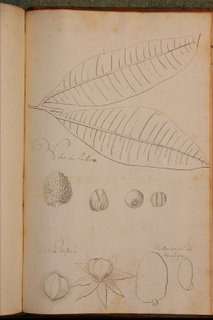josef george kamel, s.j. drawing of lychee
 Lechias. Fresh lychee [Litchi chinensis Sonn.], native to the provinces of Quanzhou and Fujian in southern China, was a harbinger of Christmas. Eagerly awaited like the mandarin oranges and the sweet chestnut, all from China, the appearance of this trio in the Philippine market in late November or early December bode that Christmas was coming. Canning, however, has made the fruit available year round and the successful cultivation of a cultivar developed in Thailand has allowed the tree to flourish in the tropical surroundings of Bulacan rather than the temperate climes to which lychee is endemic. Canned lychee is available year round while the fresh fruit is available even beyond the Christmas season.
Lechias. Fresh lychee [Litchi chinensis Sonn.], native to the provinces of Quanzhou and Fujian in southern China, was a harbinger of Christmas. Eagerly awaited like the mandarin oranges and the sweet chestnut, all from China, the appearance of this trio in the Philippine market in late November or early December bode that Christmas was coming. Canning, however, has made the fruit available year round and the successful cultivation of a cultivar developed in Thailand has allowed the tree to flourish in the tropical surroundings of Bulacan rather than the temperate climes to which lychee is endemic. Canned lychee is available year round while the fresh fruit is available even beyond the Christmas season.The tree is dimorphic, with fruiting females and non-fruiting males. The males, however, are needed to pollinate the female flowers. Lychee is pure delight. Eaten ripe it has a sweet white pulp surrounding a hard brown pith. It can be mixed with other fruits, used as a glaze or used for baked goods. Its distant cousin Rambutan (Nephelium lappaceum), introduced from Indonesia in the 1950s grows well in the Philippines.
The inclusion of lychee in Kamel's compendium raises the question whether he found the tree growing and fruiting in the Philippines or whether he drew the fruit and leaf from lychee fruit being sold in the Manila market. If Kamel drew from a living specimen, then lychee was introduced much earlier to the Philippines than is generally supposed.

0 Comments:
Post a Comment
<< Home